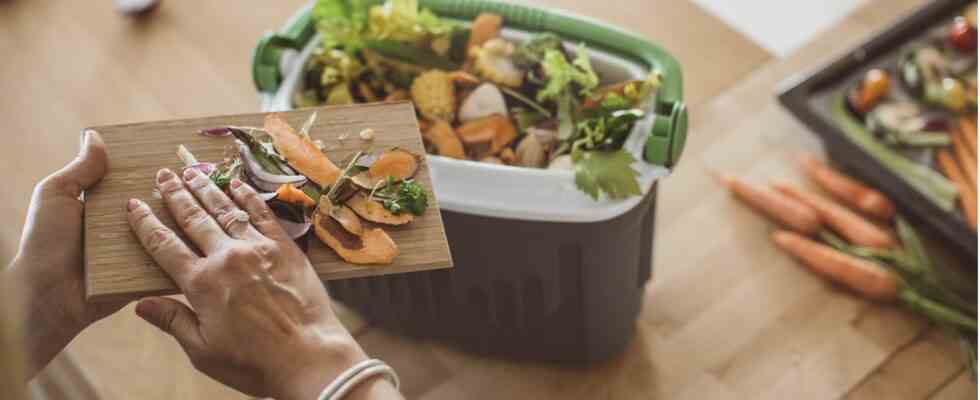kitchen composter
Bokashi Method: How to make organic fertilizer from leftover food
Reusable organic waste is fermented in a kitchen composter
© svetikd / Getty Images
Did you know that organic waste can be more than just waste? In fact, natural fertilizer for plants can be made from both raw and cooked leftovers. All you need is a special kitchen composter – also known as a bokashi.
The term “Bokashi” comes from Japan and means something like “gradation”. Because unlike ordinary compost, with this method all organic waste (including fish, meat and dairy products) is gradually decomposed – by fermentation. It’s a long, smelly process of decay that requires an airtight kitchen composter: the Bokashi bucket. By adding effective microorganisms, a mixture of lactic acid and photosynthetic bacteria as well as yeast, you get nutrient-rich fertilizer for garden and balcony plants. In the following we present four different kitchen composters. We will also tell you how to produce the fertilizer and then use it sensibly.
Four kitchen composters in comparison
1. Biolan
In this starter set comes with everything you need to start making organic fertilizer: a Bokashi bucket (10L capacity), a perforated midsole, a sealing plate and a kilogram of bran. In order to drain the content later, there is a small tap in the kitchen composter. To ensure that no odors or liquids can escape, the bucket has also been fitted with a lid seal and a safety latch.
2. FairFox
In the complete set of FairFox There are two Bokashi buckets made from recycled plastic (19 liter capacity) for fermenting organic waste. Here, too, the effective microorganisms (2 kilograms) are supplied so that you can compost your leftovers quickly, easily and odourlessly. The package also contains two sieves, two dosing caps (for the seep juice) and instructions.
3rd jewel
In cooperation with a university for microbiology, the Juwel company developed the space-saving Bokashi kitchen composter “sensei” with built-in activated carbon filter: It should be able to ferment the food leftovers of a family of four (without emptying it) within four weeks. The finished organic liquid can then be used for fertilizer via the drain tap. The Bokashi granules required for this are used included.
4. Raccoon
At Waschbär, a shop for fair ecological products, there are two kitchen composters (up to 19 liter capacity) for all leftovers, whether raw or cooked. The effective microorganisms (1 kilogram) are included in the scope of delivery and ensure that your waste is fermented and thus converted into fertilizer. You simply fill the second bucket when the first one is full and the content in it has to rest or “work”.
How to make your own fertilizer
When you get your hands on a kitchen composter, you will usually find instructions on how to make fertilizer inside. If this is not the case, you can use the following steps as a guide:
Before putting your leftovers in the bin, first place the strainer in the bokashi bucket.
Then all organic waste (fruit, vegetables, eggshells, bread) can go in. Make sure that the bottom is filled at least three to four inches high.
Mix the microbial solution according to the instructions for use and spray the organic waste with it.
Take a scoop and press the leftovers as compactly as possible so that no air can get through.
Seal the bokashi bucket airtight.
Only open and fill the bucket again when you have enough leftovers for another “shift”.
Be sure to drain the leachate regularly every 48 hours – this can already be used as fertilizer (see next paragraph below).
After the Bokashi bucket has fermented the contents at room temperature for at least two weeks, the fertilizer is ready to use.
A notice:
White mold is an indication of fermentation and not a bad sign. However, green or black mold should not appear in the process. In this case, too few microorganisms were used, there was still too much oxygen in the container or the outside temperature was too high. You can also easily clean the container with commercially available citric acid.
Use and store fertilizer correctly: this is how it works
application
If you regularly drain the ooze from your kitchen composter drain, it should be used quickly because it can become mouldy. You can use it as a lawn fertilizer, plant manure or compost accelerator. However, it is important to know that you should dilute the juice with water beforehand: preferably in a ratio of 1:100, with young plants even 1:200.
Simply mix the finished Bokashi fertilizer (about 20 centimeters deep) with loose potting soil. Depending on the manufacturer, the contents of a bucket should be enough for about 100 liters of soil. Then let the mixture sit for a week before applying the fertilized soil to your plants. The low and therefore acidic pH value would otherwise be particularly harmful to young roots.
storage
Normally, the Bokashi fertilizer can be used directly after completion. In the cold winter months, however, fertilizing your balcony and garden plants makes little sense. You should therefore store the compost juice temporarily – preferably in an airtight container. In addition, you should always store the liquid fertilizer in a cool and dry place.
Source: Utopia
You might also be interested in:
This article contains so-called affiliate links. There is more information here.


